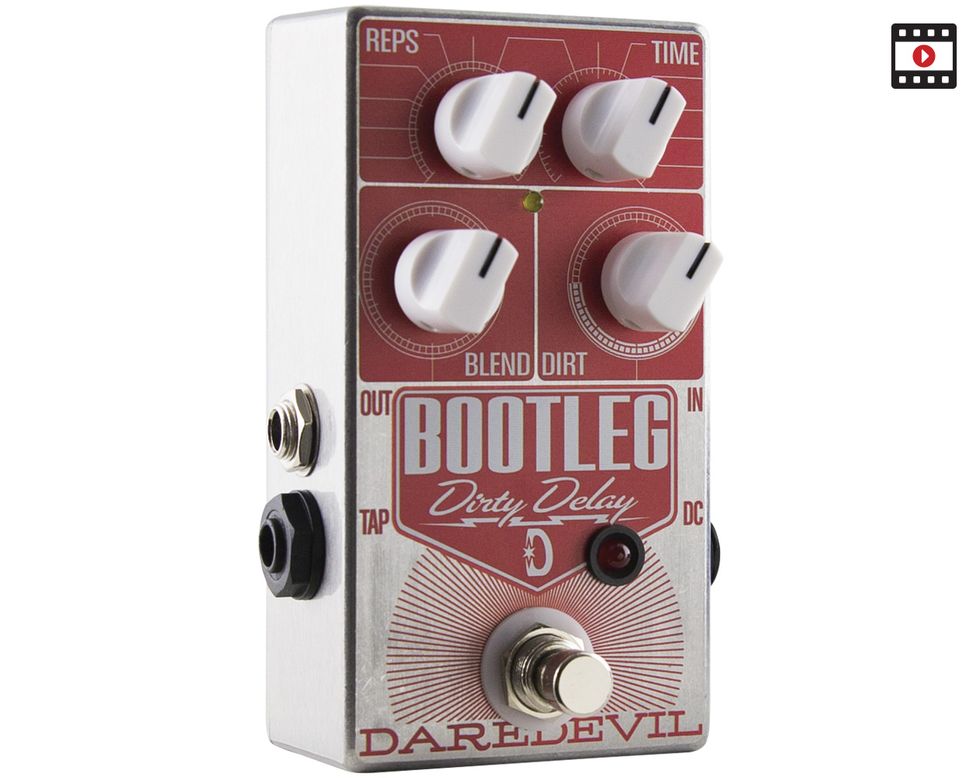The first section repeats the same phrase four times, using the both-pickups setting on the guitar, first with the Dirty Delay off, then on with Dirt knob at minimum, then Dirt knob 50%, then Dirt knob 100%.
The second passage (at 0:53) is on the guitar’s neck pickup, with more moderate Time, Reps and Blend settings, and 0% Dirt.
The third passage (at 1:26) is on the guitar’s bridge pickup, with the Dirty Delay set for slapback, and about 40% on the Dirt knob.
RatingsPros:Characterful analog delay cleverly designed to enhance the distortion inherent in classic tape echoes. Well built and simple to use. Cons: Less dirt at lowest settings would expand potential. Advanced dirt knob settings get hairy fast. Street: $199 Daredevil Bootleg Dirty Delay daredevilpedals.com | Tones: Ease of Use: Build/Design: Value: |
One of the real peculiarities of electric guitar tone is that a little distortion sounds good with just about anything. Certain playing styles and musical genres just don’t even work without some distortion coming from the amplifier. Similarly, many guitarists hooked on delay just can’t dig in quite right without a little analog fur hanging on the tail of each note.
Enter the Bootleg Dirty Delay, made by Daredevil Pedals of Chicago, Illinois. This digital pedal replicates the distortion inherent in analog delays, then emphasizes and enhances it by intentionally adding extra (and adjustable) dirt to the brew. In doing so, it suggests the preamp drive and tape distortion of old-school tape echoes, and the extra drive from analog units like the Deluxe Memory Man, while adding new twists and extra aggression in a compact easy-to-use pedal.
Repeat Offender
The Bootleg Dirty Delay is housed in a die-cast aluminum pedal box and loaded with familiar, requisite functions for any basic analog delay. Blend (aka mix), reps (repeats), and time (delay time) do exactly what you’d expect. The dirt control, however, adds extra gain to the repeats as you turn it up. There is another important difference between the Dirty Delay and most tape and analog delays: Decays become brighter as they tail off—the opposite of most tape and analog units (and their digital emulations, for that matter). Maximum delay time is 560 ms, which is in the ballpark with the Maestro EP-3 Echoplex and most classic bucket-brigade delays like the Boss DM-2 and MXR Analog Delay. And while a little over half a second might not sound like a lot by modern digital delay standards, it’s plenty for long, atmospheric echoes.
In addition to its standard mono input and output, the Bootleg also has a 1/4" jack to connect an external momentary pedal for tap-tempo selection. The 2.1 mm center-negative connection for an external power supply (not included) accepts 9V DC supplies only. No internal battery connection is available.
Inside the pedal, neatly handwired connections are made on a tidy, through-hole PCB that’s home to all circuit components, including the Princeton 2399 IC responsible for the pedal’s sweet, dirty, tape-like sound.
Dirty Dancing
I tested the Dirty Delay with a tweed Deluxe-style combo and a Friedman Small Box head and 2x12 cab, using a Gibson Les Paul Reissue and a Thorn SoCal S/S with TV Jones Classics. With each combination, the Bootleg Dirty Delay delivered mightily on its promise of crud-encrusted echo. And while it can perform a lot like a traditional semi-dirty analog delay pedal, it ultimately reveals itself as a very different creative tool compared to the average analog delay.
To be clear, there’s always at least a little distortion on the repeats from this unit. But rolling up the dirt control adds a lot of fuzzy, gritty character that’s bold and very apparent in the repeats and remains evident at high rep and blend settings. The dry signal, meanwhile, stays clean and unsullied.
I found the Bootleg particularly adept at enabling nasty rockabilly riffage, lending the edge of a half-busted Echoplex or a voltage-starved EchoSonic to everything it touched. Psychobilly, here we come! Longer delays also benefited from judicially enhanced echoes, which spiced up rhythmic Edge-like dyads (thickened with just a little dollop from the dirt knob) and propelled gnarled long-delay excursions.
Though musical, the Bootleg Dirty Delay isn’t exactly subtle. Guitarists who only need the usual little bit of analog distortion inherent in traditional tape and bucket brigade delays might find there’s too much extra distortion even at the slightest dirt settings. Curious texturalists, noise-crafters, and other delay fanatics, however, will likely enjoy exploring these more unusual textures.
The Verdict
If you’re the breed of delay fan that feels like you’re not reallyhearing echo unless there’s dirt on it, the Bootleg is a pedal well worth checking out. It’s a clever and compact design with just enough features to get the job done and no excess clutter. It’s also built robustly enough to stand the kind of abuse I suspect many distorted echo fans tend to dish out.
Watch the First Look:



























